When it comes to tree maintenance and care, two commonly used terms are tree pruning and tree felling. While they both involve working with trees, they have distinct differences in their goals and methods. In this article, we will delve into the dissimilarities between tree pruning and tree felling, explore the various steps involved in each process, highlight the benefits of hiring professionals for these tasks, and shed light on other services that arborists offer.Are Tree Pruning and Tree Felling the Same?No, tree pruning and tree felling are not the same. They serve different purposes and involve distinct techniques:

The Differences between Tree Pruning and Tree Felling
Tree Pruning: Tree pruning primarily focuses on the health and aesthetics of a tree. It involves selectively removing specific branches to enhance the tree’s structure, promote healthy growth, and improve its overall appearance. Pruning aims to eliminate dead, diseased, or damaged branches, while also addressing issues such as crossing or overcrowded branches.
Tree Felling: Tree felling, on the other hand, involves the complete removal of a tree. It is typically done when a tree poses a safety hazard, is severely diseased or damaged beyond recovery, or is obstructing construction or development. Felling requires careful planning, expert knowledge, and specialized equipment to safely bring down the entire tree.
Different Steps When Doing Tree Pruning or Tree Felling
Tree Pruning Steps:
Assessment: Arborists assess the tree’s health, structure, and specific pruning needs. They identify any hazardous branches, signs of disease, or growth issues
Planning: An appropriate pruning plan is devised, considering the tree species, growth patterns, and the desired outcome. The plan includes determining the type of pruning cuts required.
Pruning Cuts: Arborists perform various types of pruning cuts, including crown thinning (removing selective branches to improve air circulation and light penetration), crown reduction (reducing the height or spread of the tree), and deadwood removal (eliminating dead branches).
Safety Measures: Safety precautions are taken throughout the process to protect both the workers and the surrounding property.
Tree Felling Steps:
Site Assessment: Arborists evaluate the tree’s location, condition, and potential risks. They consider factors such as nearby structures, electrical lines, and the tree’s lean to determine the safest felling technique.
Clearance: The area around the tree is cleared of any obstacles to provide a safe working environment.
Cutting Technique: Arborists employ proper cutting techniques, such as making strategic notches and backcuts, to control the tree’s direction of fall and minimize any damage to nearby structures.
Tree Removal: The tree is carefully brought down, taking precautions to ensure the safety of all personnel involved and to prevent any damage to the surroundings.
Benefits of Hiring a Professional for These Tasks
Expertise and Experience: Professionals in tree pruning and felling possess the necessary knowledge, skills, and experience to assess trees, determine the appropriate techniques, and safely execute the tasks. Their expertise ensures the health of the tree and minimizes risks to property and personal safety.
Safety Precautions: Tree pruning and felling can be hazardous activities, especially when dealing with large or damaged trees. Professionals prioritize safety by using specialized equipment, following industry standards, and adhering to safety protocols to prevent accidents and injuries.
Proper Equipment: Arborists have access to specialized tools and equipment required for efficient and safe tree pruning and felling. This includes chainsaws, harnesses, rigging systems, and protective gear, which are essential for completing the tasks effectively.
Tree Health and Aesthetics: Professional pruning ensures that trees are pruned correctly, promoting healthy growth and maintaining their natural beauty. When it comes to tree felling, professionals can accurately assess the need for complete removal and ensure minimal impact on the surrounding environment.
Other Services Arborists Offer
Arborists offer a wide range of services beyond tree pruning and felling. Some additional services include:
Tree Planting: Arborists assist in selecting suitable tree species, determining optimal planting locations, and ensuring proper planting techniques are followed.
Tree Health Assessment and Treatment: Arborists evaluate the health of trees, diagnose diseases or pest infestations, and provide appropriate treatments to restore tree vitality.
Emergency Tree Care: Arborists respond to emergency situations such as storm damage, fallen trees, or hazardous limbs, providing immediate assistance and ensuring public safety.
Tree Preservation: Arborists develop strategies to protect valuable trees during construction projects, implementing measures to minimize damage to tree roots, trunks, and branches.
Conclusion
In conclusion, tree pruning and tree felling are distinct processes with different goals. Tree pruning focuses on maintaining the health and aesthetics of a tree by selectively removing specific branches, while tree felling involves the complete removal of a tree due to safety hazards or other concerns. Both tasks require expertise, careful planning, and the use of specialized equipment.

